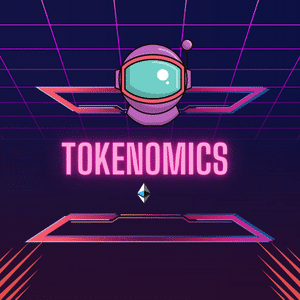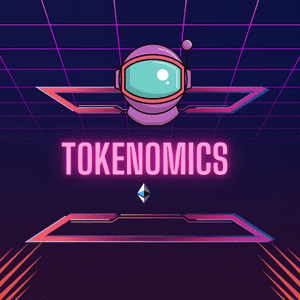What is Tokenomics? :
The term Tokenomics is derived from a combination of the words Token and Economics. A crypto token is a unit of digital currency (cryptocurrency) that can be used as an asset, a means of payment, or to represent a particular use case on a blockchain network.
Economics is generally the study of scarcity and choice in relation to the use of resources, production, consumption, and transfer of wealth.
Tokenomics describes two main things in regard to a crypto economy:
- Token distribution
- Utility of the tokens in regard to supply and demand
A lot of developers tend to deploy their own Token to empower their DApp or release incentive tokens in hopes of driving users to use their DApp as well as to retain users. Each of these tokens has its own unique set of Tokenomics and use cases that give them their market value. But there are several key factors of a token’s Tokenomics that determine the scope of users or investors who would be interested in these tokens and may have an impact on the value of a token for the long term.

Crypto Tokenomics Explanation:
The crypto token is a denomination of a cryptocurrency or a virtual currency representing a tradable asset or utility on a blockchain network that allows traders to hold it or use it for investment or economic purposes. Crypto tokens can be exchanged with other tokens on a different blockchain or held in wallets to gain value with time.
Crypto Tokenomics Classification :
Based on the Blockchain Network –
- Layer 1 Tokens – Layer 1 crypto tokens are tokens with their own blockchain. Layer 1 tokens function to provide access to the blockchain’s resources including paying for network services such as transaction fees, minting tokens, and paying for smart contracts.
- Layer 2 Tokens – Layer 2 tokens are crypto tokens without their own native blockchain networks. These tokens are integrated into Layer 1 blockchains via smart contract technology. Layer 2 tokens can be new tokens or more complex dApps project tokens. Layer 2 tokens generally function to scale decentralized applications in a network.
Functionality-based Classification –
- Fungible Tokens – Fungible tokens can be interchanged with one another of the same kind. Fungible tokens essentially have the same value and can be interchanged with one another. Bitcoin and other altcoins are the best examples of fungible tokens.
- Non-Fungible Tokens (NFTs) – NFTs are a unique form of cryptocurrency tokens that have no similar value. NFTs facilitate the tokenization of artworks, real estate, music, digital content, etc., allowing them to be held in digital forms. Think of NFTs as irrevocable digital certificates of ownership and authenticity of a particular asset whether physical or digital.
Use Case Classification –
- Utility Tokens – These are cryptocurrencies representing a value on a blockchain network. They offer particular access to products or services run or operated by a token issuer. Utility tokens can be redeemed for a defined value of a particular service or product.
- Security Tokens – Security tokens are securitized cryptocurrencies that can be traded under a financial regulation as security. They can function as securitized tokenization of bonds, stocks, properties, real-estates, and more.
- Payment Tokens – Payment tokens are used to facilitate transactions involving buying and selling goods and services on digital platforms without an intermediary.
- Exchange Tokens – Exchange tokens can be used to pay for exchange fees on cryptocurrency exchanges where buying, selling, and swapping tokens occurs.
Why Is Important :
Tokenomics is especially important in the crypto space due to its lack of regulation. Since there are no laws governing cryptocurrencies, Tokenomics provides an opportunity for cryptocurrencies to be evaluated according to their real-life merit, not just how they are traded on exchanges.
Tokenomics provides investors with an initial understanding of the value of the project, particularly the supply and demand of the token. The value of a token is determined by market demand and total supply, as well as its utility. Tokenomics can also be used as a guide for determining cryptocurrency value in the future.
It should be noted, however, that a proper coin model must first be created before any economics can be studied. This also means that Tokenomics should not come before devising a relevant business plan or concept for a new product or service that is to use blockchain technology.
The developers of a crypto token are the ones who determine its Tokenomics since they determine its features and how it works. Although Tokenomics has a broad definition, it normally refers to some combination of crypto tokens:
- Maximum Supply
- Minting or burning process
- Transaction fees
- Incentives for token holders
Generation Framework and Key elements :
There are several key factors of Tokenomics that both the developers of a token consider and a crypto investor looks at
Token supply :
If a coin has high supply-and-demand elasticity, its price will be more affected by changes in demand relative to its supply. This means that if demand for a particular coin rises, the coin will experience more positive price action ($$) than if demand for the same coin fell.
Supply and Demand Elasticity = (% change in quantity supplied) / (% change in quantity demanded).
Token Allocation :
When tokens are minted, they are usually allocated into different wallet addresses which are sometimes known as pools. These tokens are allocated depending on their usage which is ultimately determined by the developers of the token.
There are four main categories of initial asset allocation:
- public sale
- community allocations
- insiders (core team, investors & company)
- Foundations, grant pools, and rewards
Inflation :
Inflation refers to the process of locking and releasing tokens after a particular period. Usually, Inflation tokens are offered to advisors, partners, team members, and others who contribute to the development and running of the project.
This is the schedule for adding or removing tokens from circulation. Inflationary cryptocurrencies typically add blocks of transactions on a set schedule and mint a certain number of tokens per block. Deflationary cryptocurrencies may have a burn schedule or burn a percentage of every transaction.
Inflation ensures the team has a financial interest in continuing to grow the project, which in turn establishes faith in the project from investors. Without Inflation, a single or few entities with control of large proportions of the project’s token can cause price instability and pose risks to the token’s ecosystem.
Utility:
This means the cryptocurrency’s use case or the problems it aims to solve. The utility is the most important part of any cryptocurrency. If a project doesn’t have any apparent reason to exist besides memes or going up in price, that’s a clear sign to avoid it.
Community Rewards :
When a coin has a significant community, it can play a role in working to improve the coin’s fundamentals. This is an example of market-based governance that has the potential to increase the price of a coin because it’s an indicator of trust in the network.
Some Important Things Should Know For Crypto and Tokens:
What is a cryptocurrency coin?
A cryptocurrency coin is one which is native to its very own blockchain. It is a virtual currency that can be utilized as a method of payment, with transactions in a cryptocurrency coin conducted exclusively via its own blockchain. Bitcoin, the original cryptocurrency, is the best possible example of a cryptocurrency coin. It exists as a unit of value — on its own independent ledger. Some cryptocurrency coins, such as Bitcoin, are limited in their supply. Their value is, therefore, influenced by the basic principle of supply and demand.
Cryptocurrency coin use cases :
| Purpose | Explanation |
| Store of value | Crypto coins such as Bitcoin aim to offer an alternative to conventional banking. By providing decentralized transactions, Bitcoin has circumvented the need for centralized ledgers, becoming a reliable store of value. |
What is a cryptocurrency token?
Cryptocurrency Token can act as a form of payment, its primary purpose is to be used within a blockchain platform’s wider ecosystem. In many cases, cryptocurrency tokens are created to foster user interaction and innovation within a network’s community. Blockchain tokens can be dished out as a form of reward for partaking in an activity within a blockchain platform.
The most common platform for cryptocurrency tokens is Ethereum. Typically, a cryptocurrency token created using the Ethereum platform is known as an ERC20 token. If you are wondering what ERC20 tokens are, they can be stored and distributed between Ethereum addresses.
Both cryptocurrency coins and tokens can be stored together in the same compatible crypto wallet, with ‘hot’ online wallets and ‘cold’ offline wallets from which to choose
Cryptocurrency token use cases :
| Purpose | Explanation |
| Smart contracts | A smart contract is a protocol that automates transactions when mutually agreed conditions of contracts are met. It could be transformational for industries such as the property sector, by automating and Decentralising property sales. |
| Dapps | Ethereum-based crypto tokens have become integral to Dapps, open-source apps ranging from games or social media platforms such as Karma to lending platforms such as MakerDao that are pegged to the US dollar. |
Pump and Dump Schemes :
A pump-and-dump scheme is when someone buys a large amount of a particular coin, which increases its value at first. Once other investors notice the price going up, they might buy some as well. This can create a “hype” where everyone is buying the coin, leading to its price going even higher. Eventually, everyone who bought some would sell it back at a high price, which makes them profit from buying low and selling high.
In this way, pump-and-dump schemes can cause a coin’s price to be artificially inflated, and it will crash back down when all of its investors start selling off their coins.
Upcoming Phase for Tokenomics :
Since the genesis block of the Bitcoin network was created in 2009, tokenomics has evolved significantly. Developers have explored many different Tokenomics models. There have been successes and failures. Bitcoin’s Tokenomics model still remains enduring, having stood up to the test of time. Others with poor Tokenomics designs have faltered.
Non-fungible tokens (NFTs) provide a different Tokenomics model based on digital scarcity. The tokenization of traditional assets such as real estate and artworks could generate new innovations of Tokenomics in the future.
Conclusion Of Tokenomics :
Crypto Tokenomics is an incredibly important concept for both project developers and investors. For project creators, Tokenomics can make or break a project and therefore must be well formulated. Investors can use the different aspects of Tokenomics, such as market supply, allocation, and more, to determine whether a crypto project is a viable investment.
Therefore, as a beginner in the crypto space, it’s crucial to study a project’s Tokenomics, usually drafted in its documentation or white paper, to get a good sense of various Tokenomics aspects and determine if it makes sense and is sustainable for the long term.
Token governance :
Governance plays a huge role in Tokenomics these days. Lots of tokens function as so-called governance tokens, meaning that holders are granted voting rights to influence the future rules and decisions of a project. This is all in the name of decentralization; instead of a centralized group of developers calling the shots, token holders can vote on how the platform should be run.

